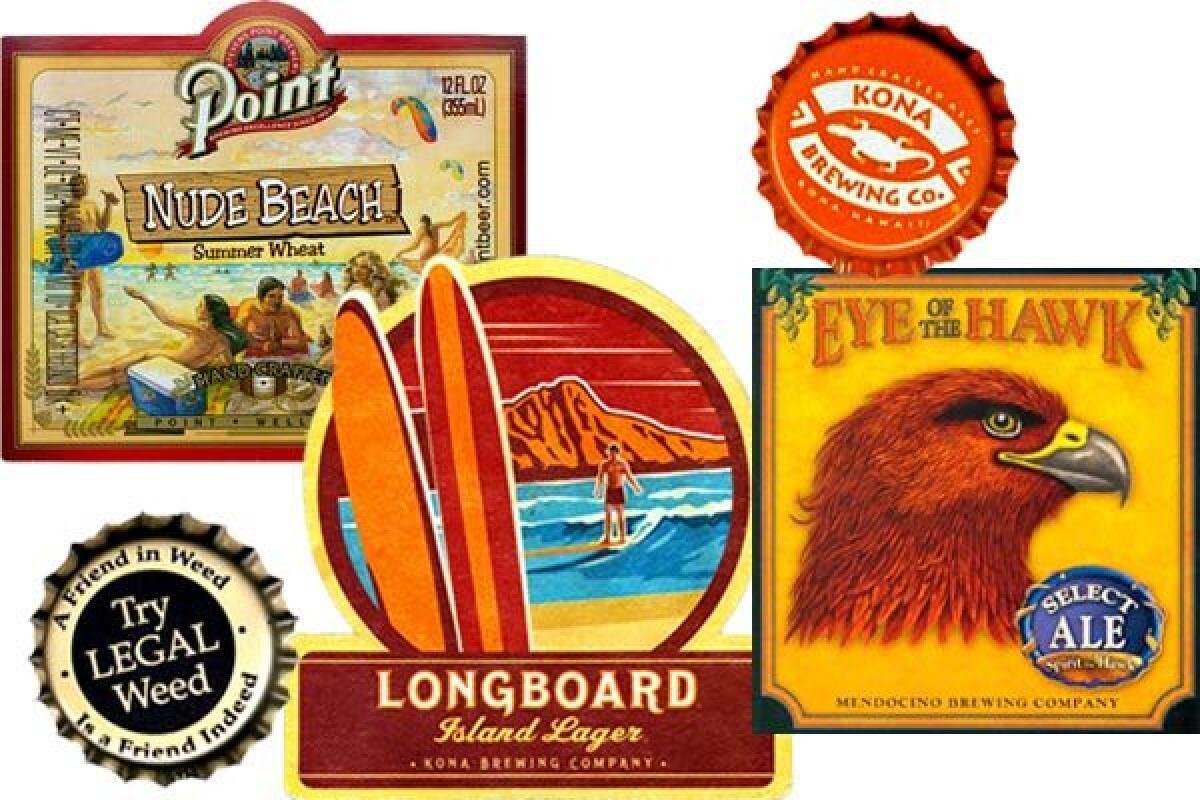Beer label art matches the quirky character of the microbrews

- Share via
True confession: The first bottle of Black Dog Ale I ever bought wasn’t for the taste or the price or even the reputation. What separated that six-pack from hundreds of others in the 40-foot-long beer case was the black Labrador retriever on the box. There he was — the noble profile, those silky ears, his golden eyes gazing into the distance. And to clinch the deal, behind him rolled a tree-filled alpine meadow, backed by snowy mountain peaks.
I didn’t buy the beer, I bought the label. And it’s not just any label. With the detailed drawing of the dog, the idealized depiction of the place, all rendered in rich colors, with an unmistakably retro vibe, it’s the modern-day version of that other icon of advertising— orange crate art.
The aesthetic of the citrus labels of the early 1900s, with their lush and idealized images of trees and fields and fruit and, of course, beautiful women, are a perfect match for locally brewed beers.
Craft beers, loosely defined as local brews produced by traditional methods, reflect not just specifics of their regions but offer a peek into the psyches of their creators as well. Like any label, those on craft beers bear a brand name and product information and meet the legal requirements of state and federal law.
But the estimated 1,500 craft brewers in the U.S., who sold slightly more than 4 million barrels of beer in the first half of 2009, are an intensely independent lot. Having broken from the conformity of so-called macro-brews, like Coors or Miller or Budweiser, microbrewers naturally take the next step and produce labels as quaint and curious and quirky as the liquid in the bottles.
“The kinds of people who start microbreweries are not your typical entrepreneurs,” says Jonathan Baker, self-described “marketing guy” of the fledgling Monday Night Brewing Co. in Atlanta. “They’re a little wilder, a little weirder, and they have a more artistic slant in general.”
Where the big brewers have the big money to hire branding experts, to research and run focus groups, the little guys rely more on self-expression to make their marketing statements.
“With microbrews, it’s often just a couple of guys making decisions based on what they like,” Baker says. “They marry the words and the art. But when you’re designing a label, you’ve still got to say something, you’ve got to have a message. It can’t just be art for art’s sake.”
At Kona Brewing Co., the message is all about Hawaii. Take Longboard Island Lager, for instance, where surfers backed by Hawaii’s volcanic mountains ride blue, blue waves toward a broad and sandy beach. The logo itself echoes a tribal tattoo, adding to the local vibe.
“Orange crates of the past were trying to deliver a sense of place,” says Mattson Davis, Kona Brewing’s president and chief executive. “Wouldn’t you like to be in this beautiful field? Wouldn’t you like to be eating this succulent fruit?”
Kona’s label is also all about the narrative, Davis says.
“Here we say, ‘Let’s go talk story,’ ” he says. “That’s the social engagement — let’s go relax. Let’s go have a beer.”
Some of the stories beer labels tell turn out to be a bit too provocative for the authorities who oversee the industry.
Nude Beach Summer Wheat Beer, produced by Stevens Point Brewery Co. in Wisconsin, was banned for the mere suggestion that the sunbathers on the bright and playful label were, well, naked behind those strategically placed surfboards and volleyballs.
State liquor authorities in Maine and New York banned the import of Santa’s Butt Winter Porter, a seasonal beer that made a visual pun out of a portly Santa seated on a wooden beer keg — known in the industry as a “butt.”
And here in California, Weed Beer, brewed in the tiny town of Weed, came under fire for its bottle cap, which jokingly urged shoppers to “Try Legal Weed.”
Are beer brewers more adventurous in marketing their wares than their distant kin, the vintners? Yes, says Keith Stevenson, advertising manager for the Mendocino Brewing Co. The company’s beers, like its Red Tail Ale, with a fierce hawk clutching a sheaf of barley in its talons, feature beautifully drawn raptors on the labels.
“Wine — for some reason there’s a certain snobbery attached to wine,” Stevenson says. “A wine ad will have strings and piano and soft lighting. Beer labels reflect the lingua franca of the public. The beer ad is earthier; it will be in-your-face.”
In the end, though, what’s on the outside of the bottle takes a back seat to what’s inside, says Davis, of Kona Brewing.
“It may be the label that makes the beer really jump off the shelf,” Davis says. “But if you don’t deliver me a good liquid? I won’t ever buy you again.”
More to Read
Eat your way across L.A.
Get our weekly Tasting Notes newsletter for reviews, news and more.
You may occasionally receive promotional content from the Los Angeles Times.










